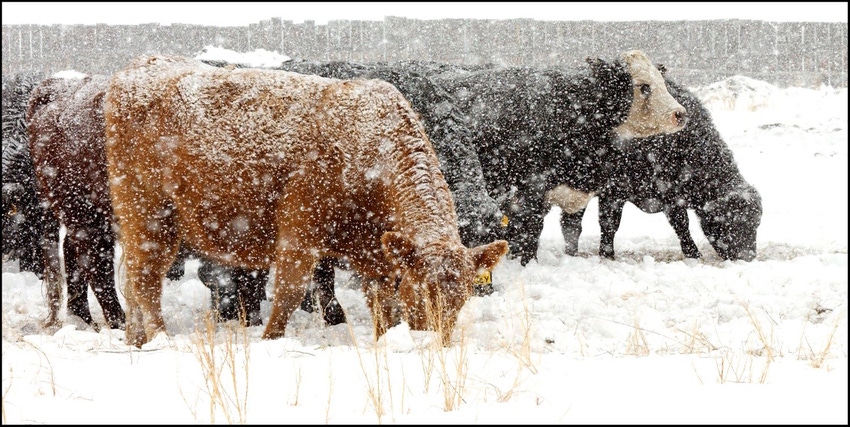Providing extra Energy in bad weather
Knowing what is in a forage helps producers to ensure they are not over feeding or underfeeding according to the needs of the animal and the weather conditions present.
February 11, 2021

Winter is here! As I write this, we have had some snow and freezing temperatures along with a healthy dose of mud, but the worst is yet to come. Some grazers may still be utilizing stockpiled forages but many of us have transitioned to feeding hay, baleage, or silage. Hopefully, we know the quality of our forage and the needs of the livestock that will be consuming it. Maybe we have even planned for supplemental energy sources when needed. This is all great until mother nature throws a monkey wrench into things. Rain, snow, wind, and mud can destroy our best laid plans.
There are charts that tell us the nutrient requirements of all types of livestock during different stages of their lives. These help us know which forages are best suited to which animals and when a supplement needs to be added to maintain performance and reach genetic potential. What we sometimes forget is these tables do not account for non-typical weather conditions. A sunny day with no wind and temperatures near zero are better tolerated than a muddy 40°F day with blowing rain.
The temperature below which an animal’s body begins to lose its normal function is called lower critical temperature (LCT). Below this temperature an animal needs to have additional energy to maintain body heat and normal body functions. For cattle with a dry average winter hair coat, the LCT is 32° F. If the hair coat is wet the LCT increases to 59° F. Goats and horses have values similar to cattle. For sheep with 2.5 inches of wool, their LCT is 28° F. For freshly shorn sheep, the LCT is 50° F. Due to the water shedding properties of wool, sheep are not as severely affected by rain as livestock with wet hair coats.
A rule of thumb for the increase in energy need is, for each 1°F wind chill value below the LCT, the animal will need an additional 1% increase in TDN (Total Digestible Nutrients, i.e. energy). With a wet hair coat this increases to a 2% increase in TDN. For example, a cow with an average winter dry hair coat and 10° F wind chill temperature would require an additional 22% TDN (32° F LCT -10° F wind chill = 22). Now let us look at a wet hair coat with a 35°F windchill. For this, LCT 59°-35°=24. Now we need to multiply this by 2 due to the wet coat. This cow will require an additional 48% TDN. So, even though the wind chill temperature is 25° F warmer than the previous example, this cow will require more than twice the additional energy that needed in the previous example.
Animals can eat more to compensate for increased energy needs. Cattle can increase consumption by near 30%, which would still not be enough for the example above. There are two things to remember. First, we need to supply more feed. If not, they just run out of feed 30% sooner and go hungry waiting for more feed to arrive. Second, poor-quality hay is slower to digest. Ruminants physically cannot eat as much poor-quality hay as good hay. The examples above show how easy it is for an animal’s energy needs to increase beyond the point where simply eating more will fix the problem.
Bad things can happen when breeding animals are losing weight. Reduced energy and weight loss during late pregnancy can lead to birthing difficulties, decreased milk production, reduced weaning weights, and an increased length of time to breed back. These issues can have effects on future years performance. The research evidence of how nutrition can affect future genetic expression of a fetus after it is born keeps building. Poor conditions during pregnancy can lead to multi-generational reductions in performance.
There are ways to help prevent these problems. First, we need to test our forage, so we know if and how much supplementation is needed. Knowing what we have helps us feed forages in a way that we are not over feeding or underfeeding according to the needs of the animal and the weather conditions present. Second, provide shelter to reduce wind chill issues. This can be a simple windbreak. While a dry inside location is great, a location that collects moisture and mud is not. Wet building conditions with limited airflow can increase problems. Third, feed late in the day if possible. Maximum production of heat typically occurs 4-6 hours after consumption. Finally, continue to feed energy at a higher level for a few days after the poor weather conditions end. Despite our best efforts the animals likely had to rely on their fat stores during the poor weather and need a little extra time to replace those stores so they will be ready for the next change in weather.
Source: Ohio State University which is solely responsible for the information provided and is wholly owned by the source. Informa Business Media and all its subsidiaries are not responsible for any of the content contained in this information asset.
You May Also Like


.png?width=300&auto=webp&quality=80&disable=upscale)
